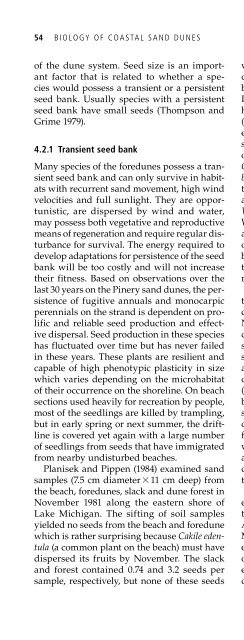The Biology of Coastal Sand Dunes M. Anwar Maun - Inecol
The Biology of Coastal Sand Dunes M. Anwar Maun - Inecol
The Biology of Coastal Sand Dunes M. Anwar Maun - Inecol
You also want an ePaper? Increase the reach of your titles
YUMPU automatically turns print PDFs into web optimized ePapers that Google loves.
54 BIOLOGY OF COASTAL SAND DUNES<br />
<strong>of</strong> the dune system. Seed size is an important<br />
factor that is related to whether a species<br />
would possess a transient or a persistent<br />
seed bank. Usually species with a persistent<br />
seed bank have small seeds (Thompson and<br />
Grime 1979).<br />
4.2.1 Transient seed bank<br />
Many species <strong>of</strong> the foredunes possess a transient<br />
seed bank and can only survive in habitats<br />
with recurrent sand movement, high wind<br />
velocities and full sunlight. <strong>The</strong>y are opportunistic,<br />
are dispersed by wind and water,<br />
may possess both vegetative and reproductive<br />
means <strong>of</strong> regeneration and require regular disturbance<br />
for survival. <strong>The</strong> energy required to<br />
develop adaptations for persistence <strong>of</strong> the seed<br />
bank will be too costly and will not increase<br />
their fitness. Based on observations over the<br />
last 30 years on the Pinery sand dunes, the persistence<br />
<strong>of</strong> fugitive annuals and monocarpic<br />
perennials on the strand is dependent on prolific<br />
and reliable seed production and effective<br />
dispersal. Seed production in these species<br />
has fluctuated over time but has never failed<br />
in these years. <strong>The</strong>se plants are resilient and<br />
capable <strong>of</strong> high phenotypic plasticity in size<br />
which varies depending on the microhabitat<br />
<strong>of</strong> their occurrence on the shoreline. On beach<br />
sections used heavily for recreation by people,<br />
most <strong>of</strong> the seedlings are killed by trampling,<br />
but in early spring or next summer, the driftline<br />
is covered yet again with a large number<br />
<strong>of</strong> seedlings from seeds that have immigrated<br />
from nearby undisturbed beaches.<br />
Planisek and Pippen (1984) examined sand<br />
samples (7.5 cm diameter × 11 cm deep) from<br />
the beach, foredunes, slack and dune forest in<br />
November 1981 along the eastern shore <strong>of</strong><br />
Lake Michigan. <strong>The</strong> sifting <strong>of</strong> soil samples<br />
yielded no seeds from the beach and foredune<br />
which is rather surprising because Cakile edentula<br />
(a common plant on the beach) must have<br />
dispersed its fruits by November. <strong>The</strong> slack<br />
and forest contained 0.74 and 3.2 seeds per<br />
sample, respectively, but none <strong>of</strong> these seeds<br />
was viable. It was concluded that coastal foredunes<br />
do not have a seed bank primarily<br />
because <strong>of</strong> substrate instability. Similarly,<br />
Looney and Gibson (1995) showed that in four<br />
habitats, the frequently disturbed beaches<br />
(extensive sand movement, salt spray), unvegetated<br />
sandy areas, early successional dredge<br />
spoils and the strand <strong>of</strong> a coastal barrier island<br />
<strong>of</strong> Florida, the seed banks <strong>of</strong> Cakile constricta,<br />
Oenothera humifusa, Iva imbricata, Hydrocotyle<br />
bonariensis and Heterotheca subaxillaris were<br />
transient and poorly developed. <strong>The</strong> dune<br />
annuals, Cerastium atrovirens (Mack 1976),<br />
Vulpia fasciculata and V. ciliata (Carey and<br />
Watkinson 1993) at Aberffraw, North Wales,<br />
also did not have any carry-over <strong>of</strong> seeds from<br />
one year to the next. This is rather surprising<br />
because annuals or biennials are more likely<br />
to have persistent seed banks in habitats with<br />
recurrent disturbance (Thompson et al. 1998).<br />
Baptista and Shumway (1998) determined<br />
the seed bank composition <strong>of</strong> sand dunes with<br />
different disturbance histories at Cape Cod<br />
National Seashore and found that both the<br />
density <strong>of</strong> viable seeds in sand samples and<br />
species diversity were very low (Table 4.1). <strong>The</strong><br />
seeds exhibited a clumped distribution, probably<br />
because <strong>of</strong> (i) accumulation <strong>of</strong> seeds in<br />
depressions following wind dispersal, and<br />
(ii) burial <strong>of</strong> complete infructescences <strong>of</strong> plants<br />
before the release <strong>of</strong> their seeds. A similar<br />
seed bank pattern was also observed in desert<br />
dunes by Kemp (1989), who concluded that the<br />
frequency <strong>of</strong> seed distribution was kurtotic,<br />
with a large number <strong>of</strong> seeds in some samples<br />
and a few or none in most and that the abundance<br />
<strong>of</strong> a species was not a good predictor <strong>of</strong><br />
the abundance <strong>of</strong> its seeds in the seed bank.<br />
Seed bank dynamics <strong>of</strong> Cirsium pitcheri, an<br />
endangered species in Canada and federally<br />
threatened species in the United States <strong>of</strong><br />
America, was examined by Rowland and<br />
<strong>Maun</strong> (2001). <strong>The</strong>y removed 700 cores <strong>of</strong> sand<br />
each 2.5–5.0 cm diameter × 35 cm deep located<br />
on transects perpendicular to the beach and<br />
extending to the leeward side <strong>of</strong> the second<br />
dune ridge. <strong>The</strong>y then sifted the sand to

















